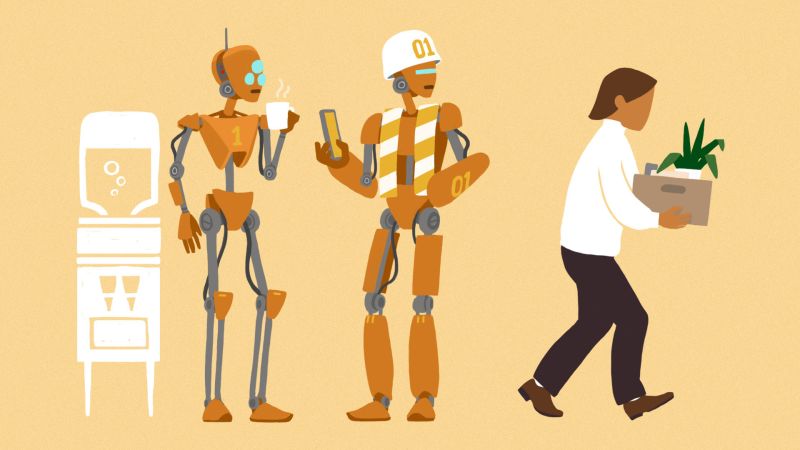The advent of artificial intelligence (AI) has spurred serious discussions around its potential impact on employment. The longstanding fear of machines stealing jobs has resurfaced with renewed intensity as companies increasingly integrate AI into their operations. In recent months, major tech figures such as Anthropic’s CEO Dario Amodei have projected concerning statistics, warning that the implementation of AI could lead to a staggering 20% unemployment rate among white-collar workers within a span of five years. Industry giants like Meta, Microsoft, and Salesforce are already leveraging AI to automate tasks that were traditionally performed by humans. Such trends have compelled leaders from Amazon to JPMorgan to underscore that their workforce may dwindle as a result of advancing technology.
Despite these warnings, skepticism prevails regarding the future labor landscape. The assertion that AI’s capabilities will inevitably displace countless workers serves as a potent promotional message for those peddling AI solutions, while simultaneously providing corporate executives with a convenient rationale for workforce reductions. The emerging consensus among a variety of tech industry insiders suggests that the relationship between AI and employment is not as straightforward as it seems. Many experts, including Nvidia CEO Jensen Huang and Google DeepMind CEO Demis Hassabis, have indicated that AI will not kill jobs unless society runs out of innovative ideas. They downplay the notion of a “jobpocalypse,” arguing that fears of mass unemployment warrant a more nuanced examination.
It is important to highlight that while numerous tech firms are downsizing their human workforce, AI’s integration is reshaping job responsibilities in unprecedented ways. Almost everyone involved anticipates a transformation in the nature of work itself—how tasks are carried out and what roles employees perform. A survey from Pew Research Center reported that a significant 54% of Americans express concerns regarding AI’s impact on their jobs, and 33% fear diminished job prospects over time. This anxiety is often compounded by headlines detailing AI’s missteps, such as notorious chatbots producing offensive content or irrelevant information, making it challenging for the public to trust an impending shift toward an AI-driven workforce.
Gaurab Bansal, executive director at Responsible Innovation Labs, encapsulates this sentiment by suggesting that while displacement of certain roles may occur, new job categories will emerge. This belief leads to the notion that AI will fundamentally reshape rather than simply eradicate existing jobs. As organizations grasp the transformative potential of AI technology, the future job market remains unpredictable. Bansal contemplates a period of uncertainty lasting at least a decade, emphasizing that the conversation around AI’s impact is evolving with increasing urgency.
In Silicon Valley and beyond, the discourse has shifted from speculation within select circles to a more public dialogue, largely driven by the recent rollout of complex “agentic AI” tools. These tools are capable of performing intricate tasks independently, surpassing previous limitations of chatbot interactions. Notably, OpenAI and Anthropic have rolled out new capabilities allowing AI systems to execute multi-step tasks with minimal human intervention. For instance, Amazon reported that its AI developer agent successfully upgraded an astonishing 30,000 software applications in just six months—a feat that would typically require thousands of human developers.
Experts like Steven Adler, a former researcher at OpenAI, remark on the relative simplicity of adopting AI as a substitute for traditional labor. Unlike previous industrial automation, AI does not require substantial financial investments in physical infrastructure, making integration smoother for many organizations. While roles in data analysis and programming are particularly vulnerable to disruption, many experts posit that the majority of positions will see changes that enhance the working environment rather than lead to total job loss. Employees may find themselves with more time for creative or interactive responsibilities as AI takes over repetitive tasks.
Though many tasks have the potential for automation, leaders like Yann LeCun, Chief AI Scientist at Meta, assert that jobs cannot be fully automated. AI may excel in specific areas but is unable to replicate the complexities and nuances of most roles. Moreover, as the economy adapts to these changes, initiatives are underway to prepare the workforce for the AI age. Partnerships between tech companies and educational institutions are aimed at developing necessary skills for future employment.
In light of these shifts, some believe AI will displace jobs while generating new opportunities that are currently unimaginable. Historical precedents from the Internet boom underscore how new technologies lead to job creation and economic growth, which Dan Priest, PwC’s Chief AI Officer, affirms. However, concerns persist regarding how organizations might rush into layoffs or reforms without fully understanding AI’s capabilities or limitations.
The transition to an AI-integrated economy may not be comfortable and could result in wage depressions among white-collar workers as productivity rises. Adler points out that while AI could augment individual capabilities, it also creates a potential surplus in labor, affecting wage dynamics if demand doesn’t keep pace. To mitigate these shifts and ensure equitable opportunities, experts like Bansal advocate for a revised economic framework that addresses the challenges of AI and creates a new social contract between workers and the economy.
As we navigate this AI-driven future











